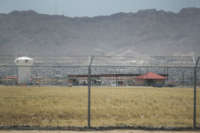
Texas Republicans are pushing legislation that advocates say will “gerrymander” the state’s appeals courts after Democrats swept judicial races in districts serving Dallas, Houston and Austin.
The Texas Senate Jurisprudence Committee on Thursday advanced SB 11, a bill introduced by Republican committee chair Joan Huffman to redraw the boundaries of the state’s court of appeals districts. The bill and its state House counterpart in their current form propose only minor tweaks to several districts — but voting advocates warn they are “shell” bills that will soon be loaded with much bigger changes based on proposals from a powerful group to “gerrymander” court districts just months after Democratic judges swept appellate races in five of the state’s 14 districts.
The bill is expected to be based on proposals by Texans for Lawsuit Reform, a deep-pocketed legal advocacy group that urged lawmakers to merge the state’s 14 districts into five to seven mega-districts, which advocates say are designed to dilute the power of urban areas and make it difficult for Democrats to win in the future.
“This is 100% partisan driven,” Anthony Gutierrez, executive director of the voter advocacy group Common Cause Texas. said in an interview with Salon. “The political party they don’t like is winning too many districts, so they just want to change them so that can no longer happen.” Gutierrez testified at Thursday’s hearing.
Texas is one of two states where Republicans are seeking to redistrict courts after the 2020 election, and GOP legislators in several other states have advanced legislation seeking to reform their judicial systems for partisan gain. Pennsylvania Republicans are also pushing an amendment that could “gerrymander” the state’s courts, Alicia Bannon, who heads the Fair Courts Project at the Brennan Center for Justice at NYU Law School, said in an interview with Salon. Though the effort was originally born out of a ruling striking down a partisan Republican gerrymander, in recent months “the court’s also been targeted for its role in some of the decisions in connection with the 2020 election ensuring that people had a meaningful opportunity to vote,” she said.
State courts played an outsized role in the 2020 election as former President Donald Trump and his allies pushed dozens of baseless lawsuits alleging election fraud without any evidence. They could play an even greater role in the coming months as Republican state lawmakers push more than 360 bills to restrict voting in 47 states, according to an analysis by the Brennan Center, including more than two dozen in Texas. Republicans are also gearing up for a new round of legislative redistricting that could cement GOP minority rule for the next decade after the Supreme Court ruled that federal courts had no jurisdiction over partisan gerrymanders.
The Texas bill offers few details but is ultimately expected to include some version of reforms proposed by Texans for Lawsuit Reform, according to Gutierrez and news reports. The group released a lengthy report proposing a plan that would shrink the state’s 14 court districts to seven, along with three other plans to reduce that number to just five.
“We’re fairly sure it will be one of those proposals, or something closely modeled there, and generally what people expect is taking the current composition of the court and reducing it, probably almost in half, to create these mega-districts where you would have maybe one Democrat. But the majority of those court of appeals districts would then become completely controlled by Republicans,” Gutierrez said.
A spokesman for Huffman did not respond to questions from Salon.
The National Democratic Redistricting Committee said it is monitoring the “judicial gerrymandering” bill.
“NDRC strongly believes that the entire redistricting process should be free of map manipulation and that includes municipal and judicial processes as well,” Molly Mitchell, a spokeswoman for the group, said in a statement to Salon. “When it comes to judges — who are meant to be impartial arbiters — making sure they are not manipulated by a hyper partisan redistricting process is critical.”
Texans for Lawsuit Reform argue that the courts should be consolidated to address unequal workloads and to make the system more efficient. But David Slayton, administrative director of the Texas Office of Court Administration, told the legal news outlet Texas Lawyer that the idea to redraw appeals court boundaries did not come from the Texas judiciary, suggesting the push came from the group. George Christian, senior counsel for the lawsuit reform group Texas Civil Justice League, told the outlet he agrees that changing the district boundaries could make the court system more efficient, but said the current effort raises obvious questions about partisanship.
“There is a very legitimate question people will ask,” he said. “Why the sudden interest in the appellate courts, now that a lot of Democrats are winning those elections?”
Texans for Lawsuit Reform, which bills itself as a nonpartisan group of “lawyers who want the civil justice system in Texas to be efficient and fair,” argues that the state would save money with fewer courts and eliminate docket equalization, which results in the transfer of cases between court districts and is “generally unpopular with litigants, lawyers, and justices.”
“Our 14 appellate courts have unequal workloads, and in some parts of our state, a district court answers to several different appellate courts. Texas should consolidate its intermediate appellate courts to achieve more efficiency and administrative rationality,” the group’s website says.
Gutierrez told Salon that there is a legitimate need to address drastic differences in caseloads, but that the current effort is a political exercise.
“We’ll see what the actual bill looks like, but if you wanted to seriously address that problem, I think you would be more transparent about what’s in the bill and bring in more of the stakeholders who really know these courts and understand the caseloads and impacts,” he said. “But the people in the room who are involved in this are Texans for Lawsuit Reform. That seems to be it.”
Though Democrats have little say in the GOP-dominated Texas legislature, the bill could face strong pushback from rural areas of the state that will be heavily impacted. Yvonne Rodriguez, chief justice of the state’s 8th Court of Appeals in El Paso, told local news outlet El Paso Matters that she believes the details of the legislation are intentionally being kept under wraps so Republican sponsors can spring it at the “last possible moment” to avoid giving opponents “any time to really mount a defense against it.”
Rodriguez warned in an interview with Texas Lawyer that the Texans for Lawsuit Reform proposals would combine her court with larger urban districts and force attorneys and litigants to travel hundreds of miles to the nearest appellate court while resulting in higher legal bills and job losses.
“That is the worst result we could reach,” state Rep. Joe Moody, a Democrat who represents El Paso, told El Paso Matters.
El Paso’s Democratic court could be merged with a heavily Republican area or combined with other Democratic areas to create Republican majorities in other districts.
State Sen. Cesar Blanco, who represents the city, told the outlet that such a measure would disenfranchise heavily Democratic voters.
“Redistricting is always very politically motivated. It’s about who gets what, it’s about keeping and managing power, and I think this consolidation is a move to do that,” he said.
“If you live in a rural part of the state, the odds of you ever again being able to elect the traditional candidate that you’re familiar with, who knows your community, go down practically to zero,” Gutierrez told Salon, adding that heavily minority parts of South Texas would be heavily impacted as well as whiter, more conservative parts of the state.
The latter aspect poses the biggest threat to the bill.
“They went out of their way to really innovate gerrymandering in Texas, which is hard to do but they figured out a way. But this is one that I feel harms so many different communities,” Gutierrez said, predicting that the impact on traditionally Republican areas of the state could doom the bill in committee.
“There are definitely a lot of groups who represent minority Texans or parts of the state along the border” who oppose the bill, he added, but “I think we’re going to find a lot of groups in red or rural parts of Texas that hate the bill just as much.”
The state’s Senate Jurisprudence Committee hearing also included SB 1529, which Gutierrez described as a backup bill “clearly intended” as a plan to offer a “different way to reconfigure the courts in Texas” if SB 11 fails.
It “basically creates what people are referring to as a business court,” he explained. “Right now, anything civil goes through the court of appeals system, but the business court would be a statewide court, like our Texas Supreme Court. Civil matters that would normally go to the court of appeals will go to that court. It’s Texas, so automatically these default to Republican judges for the foreseeable future. It definitely seems to be part of a plan to address what they see as the problem: Democrats winning a bunch of these traditional court of appeals races.”
The effort underscores Republicans’ focus on reshaping the judiciary in states, often in “retaliation against particular decisions coming out of the court,” Bannon (of the Brennan Center) told Salon. Legislators in at least 17 states proposed at least 42 bills last year to “diminish the role or independence of state courts,” according to a Brennan Center analysis.
Perhaps the most noteworthy is Pennsylvania’s effort to pass a constitutional amendment that would “open the door to gerrymandering the judicial system,” Bannon said. That effort has extended into this year and took on additional importance after Republicans waged a failed months-long effort to overturn Trump’s electoral defeat in that state.
Republicans, who tried and failed to impeach judges who had struck down their partisan gerrymander, earlier this year advanced a measure aimed at changing the way appellate judges are elected. Judges are currently elected statewide and a majority are from urban areas near Philadelphia and Pittsburgh. The GOP proposal would replace the existing system with judicial districts drawn by the Republican-led legislature every 10 years — apparently in hopes of reshaping the state Supreme Court’s 5-2 Democratic majority, after it repeatedly ruled against them. The effort could mirror the state’s legislative gerrymandering, which has allowed Republicans to control the state House since 2011 and the state Senate since 1993, even though Democrats routinely win statewide races.
Republicans argue the amendment, which cannot be vetoed by Democratic Gov. Tom Wolf, is intended to “include the full diversity of Pennsylvania’s appellate courts.” But Democrats say the new effort is an extension of the state GOP’s success at gerrymandering its way into power.
“A decade ago, Pennsylvania Republicans gerrymandered themselves into majorities in the legislature and congressional delegation,” former Attorney General Eric Holder, chairman of the National Democratic Redistricting Committee, told The New York Times. “Now that their grip on power has been forcibly loosened by the courts, they want to create and then manipulate judicial districts in a blatant attempt to undermine the independence of the judiciary and stack the courts with their conservative allies.”
The bill already passed the House last year but needs to be passed by both chambers this year to make it onto the ballot. Republicans hoped to advance the measure in time for the amendment to appear on the ballot in May’s primary elections, but that effort has been delayed. Senate President Pro Tem Jake Corman, a Republican, vowed that the measure was not dead and the legislature would soon hold hearings on the issue and perhaps look at alternative options to changing judicial elections.
Meanwhile, more than 100 advocacy groups and labor unions have signed a letter to state lawmakers warning that the plan is “the largest attempt to disenfranchise Pennsylvanians in the history of our Commonwealth” and “a massive threat to the independence of our judiciary.”
Republicans in Tennessee launched a different kind of effort in response to the court rulings surrounding the 2020 election, moving to remove a Nashville judge who ruled to expand absentee voting amid the coronavirus pandemic. The effort ultimately failed after widespread condemnation. “That was just another example of a bill that was very explicitly linked to decisions coming out of the 2020 election,” Bannon told Salon.
The Republican push to reshape state courts comes after a successful four-year campaign to reshape the federal judiciary. Senate Republican Leader Mitch McConnell, R-Ky., led the confirmation of more than 220 federal judges and three new Supreme Court justices after blocking many of former President Barack Obama’s nominees, including his 2016 Supreme Court pick, Merrick Garland (who is now attorney general).
Unlike the federal judiciary, the efforts to remake state courts have received relatively little attention.
“State supreme courts are extremely powerful bodies that often fly under the radar,” Bannon said. “Ninety-five percent of all cases are filed in state court. State supreme courts are usually the final word in interpreting state laws and state constitutions, and they have a great deal of power in everything from voting rights to environmental issues, corporate law issues and criminal justice. They’re very powerful bodies and people often don’t pay a lot of attention.”
Though the Pennsylvania effort is clearly partisan, “in other instances, it’s harder to point to one particular opinion or decision coming out of a court,” she added. “Rather what you see is a broader effort to gain more political control over the judiciary.”
In Montana, newly-elected Republican Gov. Greg Gianforte signed a bill earlier this year that gives him the power to appoint anyone he wants to fill judicial vacancies, rather than being required to choose from a list of nominees vetted by an independent commission.
“That’s another kind of instance where we’re seeing political actors basically trying to inject more politics into the selection process,” Bannon said.
Other recent efforts have seen mixed success. Despite assailing Democrats over calls to expand the federal judiciary, Republicans successfully packed the Georgia and Arizona Supreme Courts, giving GOP governors even more power in states that are increasingly trending toward Democrats. Both states “added seats to the court in a pretty overt effort for overtly partisan benefit,” Bannon said.
Kansas lawmakers responded to a court ruling requiring additional funding for public education by passing a law that threatened to defund the entire state judiciary before it was overturned.
North Carolina has also advanced numerous bills that would “politicize the court,” with varying degrees of success, pushing to change judicial selection methods and undermine Democratic Gov. Roy Cooper’s judicial appointment power, Bannon said. “The common denominator was basically trying to give the legislature more power over judicial selection and essentially seeking a partisan advantage in those courts.”
For the most part, however, efforts to politicize the courts have failed once voters caught on. Just one of the more than 40 bills to undermine the power or independence of state courts proposed last year ended up passing, according to the Brennan Center.
“One thing we’ve seen in a number of states where courts have been targeted this way is that when the public does pay attention to this issue, they don’t like what they’re seeing,” Bannon said. “People understand the importance of having an independent judiciary. They don’t want judges to be just another set of politicians and they don’t like power grabs with respect to the courts. … I think people on the whole understand the importance of an independent judiciary. But given the centrality that state courts play, I think it’s a real worry that this is just the tip of the iceberg, in terms of the kinds of attacks we’re going to see going forward.”
This post was originally published on Latest – Truthout.





























